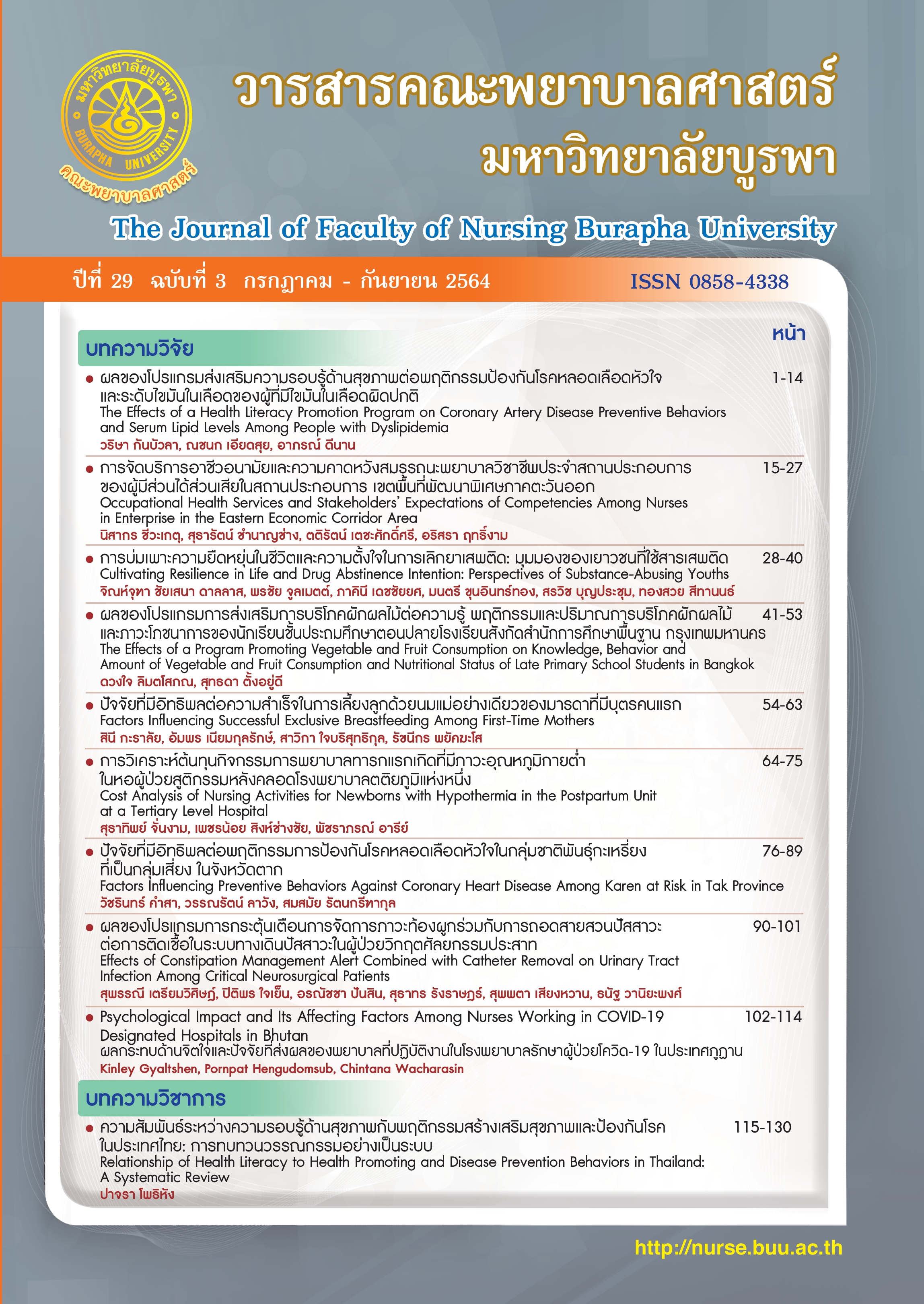ผลของโปรแกรมการกระตุ้นเตือนการจัดการภาวะท้องผูก ร่วมกับการถอดสายสวนปัสสาวะต่อการติดเชื้อในระบบทางเดินปัสสาวะ ในผู้ป่วยวิกฤตศัลยกรรมประสาท
คำสำคัญ:
การกระตุ้นเตือนการจัดการภาวะท้องผูก, ผู้ป่วยศัลยกรรมประสาทวิกฤต, การติดเชื้อระบบทางเดินปัสสาวะบทคัดย่อ
งานวิจัยนี้มีวัตถุประสงค์เพื่อเปรียบเทียบการติดเชื้อในระบบทางเดินปัสสาวะระหว่างผู้ป่วยวิกฤตศัลยกรรมประสาทที่ได้รับและผู้ป่วยที่ไม่ได้รับโปรแกรมการกระตุ้นเตือนการจัดการภาวะท้องผูกและถอดสายสวนปัสสาวะภายใน 5 วัน และศึกษาปัจจัยเสี่ยงต่อการติดเชื้อระบบทางเดินปัสสาวะที่สัมพันธ์กับการคาสายสวนปัสสาวะ กลุ่มตัวอย่างเป็นผู้ป่วยวิกฤตศัลยกรรมประสาทที่มีภาวะท้องผูกและมีการสวนคาสายปัสสาวะ กลุ่มที่ได้รับโปรแกรมฯ จำนวน 228 คน และกลุ่มที่ไม่ได้รับโปรแกรมฯ จำนวน 292 คน วิเคราะห์ข้อมูลด้วยสถิติพรรณนาและสถิติการถดถอยพหุโลจิสติก
ผลการวิจัยพบว่า กลุ่มที่ได้รับโปรแกรมการกระตุ้นเตือนการจัดการภาวะท้องผูกและถอดสายสวนปัสสาวะภายใน 5 วัน มีอัตราการเกิดการติดเชื้อในระบบทางเดินปัสสาวะน้อยกว่ากลุ่มที่ไม่ได้รับอย่างมีนัยสำคัญทางสถิติ (ร้อยละ 2.2 และ 7.2 ตามลำดับ, p < .05) นอกจากนี้ยังพบว่าการคาสายสวนปัสสาวะที่นานกว่า 5 วัน และระยะเวลาการนอนในหอผู้ป่วยเกินหนึ่งสัปดาห์เป็นปัจจัยเสี่ยงต่อการติดเชื้อในระบบทางเดินปัสสาวะอย่างมีนัยสำคัญทางสถิติ (p < .05)
ดังนั้นพยาบาลควรนำโปรแกรมการกระตุ้นเตือนการจัดภาวะท้องผูกและการถอดสายสวนปัสสาวะภายใน 5 วัน ไปใช้เพื่อลดการติดเชื้อทางเดินปัสสาวะ ซึ่งเป็นวิธีการที่ง่ายและควรสื่อสารในทีมการดูแลให้เข้าใจก่อนใช้
เอกสารอ้างอิง
Position Statement on Constipation. (2018).
Constipation. Retrieved from http://www.
gastro.org/guidelines/constipation-#sec1
Azevedo, R. P. D., & Machado, F. R. (2013).
Constipation in critically ill patients: Much
more than we imagine. Rev Bras Ter
Intensiva. 25(2): 73-74. doi:10.5935/0103-
507X.20130014. Retrieved from https://
www.ncbi.nlm.nih.gov/pmc/articles/PMC
4031826/
Bernard, R. (2000). Fundamentals of biostatistics
(5th ed.). Duxbery: Thomson learning.
Centers for Diseases Control and Prevention.
(2018). Device-associated module: UTI.
Retrieved from: https://www.cdc.gov/nhsn/
pdfs/pscmanual/7psccauticurrent.pdf.
Chen, Y.-Y., Chi, M.-M., Chen, Y.-C., Chan, Y.-J.,
Chou, S.-S., & Wang, F.-D. (2013). Using a
criteria-based reminder to reduce use of
indwelling urinary catheters and decrease
urinary tract infections. American Journal
of Critical Care, 22(2), 105-114. doi:10.4037/
ajcc2013464
Fakih, M. G., Watson, S. R., Greene, M. T., Kennedy,
E. H., Olmsted, R. N., Krein, S. L., & Saint, S.
(2012). Reducing inappropriate urinary
catheter use: A statewide effort. Archives
of Internal Medicine, 172(3), 255-260. doi:
10.1001/archinternmed.2011.627.
Fennessy, G. J., & Warrillow, S. J. (2012).
Gastrointestinal problems in intensive care.
Aneasthesia and Intensive Care Medicine,
13(4), 152-157. Retrieved from https://doi.
org/10.1016/j.mpaic. 2012.01.004
Fleiss, J. L., Levin, B., & Paik, M. C., (2003).
Statistical methods for rates and
proportions (3rd ed.). New Jersey: John
Wiley & Sons.
Horan, T. C., Andrus, M., & Dudeck, M. A. (2008).
CDC/NHSN surveillance definition of health
care-associated infection and criteria for
specific types of infections in the acute care
setting. American Journal of Infection
Control, 36(5), 309-332. doi:10.1016/j.ajic.
2008.03.002
Indrawattana, N., & Vanaporn, M. (2015).
Nosocomial infection. Journal of Medicine
and Health Science, 22(1), 81-92.
Infectious and control Maharaj Nakorn Chiang Mai
Hospital committee. (2013). Hospital
standard policy and 5 days off for CAUTI
prevention. Retrieved from http://www.
med.cmu.ac.th/ hospital/ha /HA/Plates/
5day%20off.pdf. [in Thai].
Infectious and control Maharaj Nakorn Chiang Mai
Hospital committee. (2016). Practice
guideline for hospital infection prevention
and control in Maharaj Nakorn Chiangmai
Hospital. Chiang Mai: Faculty of Medicine
Chiang Mai University. [in Thai]
Jaiyen, P., Punsin, O., Rungrat, S., Seangwan, S.,
Triamvisit, S., & Vaniyapong, T. (2017). PCT
neurosurgery pilot project: Risk factors of
catheter-associated urinary tract infection
in neurosurgical critical care patients. Chiang
Mai: Chiang Mai Regional Forum [in Thai].
Jaiyen, P., Punsin, O., Rungrat, S., Seangwan, S.,
Triamvisit, S., & Vaniyapong, T. (2018). PCT
neurosurgery quality improvement project:
Constipation management alert combined
with catheter removal within five days to
reduce catheter associated urinary tract
infection in neurosurgical critical care
patients. Chiang Mai: Chiang Mai Regional
Forum [in Thai].
Kim, B., Pai, H., Choi, W. S., Kim, Y., Kweon, K. T.,
Kim, H. A., … Kim, J. (2017). Current status
of indwelling urinary catheter utilization
and catheter-associated urinary tract
infection throughout hospital wards in
Korea: A multicenter prospective
observational study. PLOS ONE, 12(10), 1-11.
doi: 10.1371/journal.pone.0185369
Maharaj Nakorn Chiang Mai Hospital. (2021).
Medical records and statistics, Maharaj
Nakorn Chiang Mai Hospital. (2014-2020).
Chiang Mai: Faculty of Medicine Chiang Mai
University. [in Thai]
Masri, Y., Abubaker, J., & Ahmed, R. (2010).
Prophylactic use of laxative for constipation
in critically ill patients. Ann Thorac Med,
5(4), 228-231. doi:10.4103/1817-1737.69113
Meddings, J., Rogers, M. A. M., Macy, M., &
Saint, S. (2010). Systematic review and
meta-analysis: Reminder systems to reduce
catheter-associated urinary tract infections
and urinary catheter use in hospitalized
patients. Clinical Infectious Diseases, 51(5),
550-560. doi:10.1086/655133
Meddings, J., Rogers, M. A. M., Krein, S. L., Fakih,
M. G., Olmsted, R. N., & Saint, S. (2013).
Reducing unnecessary urinary catheter use
and other strategies to prevent catheterassociated
urinary tract infection: An
integrative review. BMJ Quality & Safety,
23(4), 277-289. doi:10.1136/bmjqs-2012-
001774
Meddings, J., Saint, S., Krein, S. L., Gaies, E., Reichert,
H., Hickner, A., … Mody, L. (2017).
Systematic review of interventions to
reduce urinary tract infection in nursing
home residents. Journal of Hospital
Medicine, 12(5), 356-368. doi:10.12788/
jhm.2724
Mostafa, S. M., Bhandari, S, Ritchie, G., Gratton, N.,
& Wenstone, R. (2003). Constipation and its
implications in the critically ill patient. Br J
Anaesth, 91(6), 815-9.
Nassar, A. P.Jr, da Silva, F. M., & de Cleva, R.
(2009). Constipation in intensive care unit:
Incidence and risk factors. J Crit Care, 24(4),
9-12. doi:10.1016/j.jcrc.2009.03.007
Ngamjarus, C., & Chongsuvivatwong, V. (2016).
n4Studies: Sample size calculation for an
epidemiological study on a smart device.
Siriraj Med J, 68(3), 160-170.
Nicolle, L. E. (2014). Catheter associated urinary
tract infections. Antimicrobial Resistance
and Infection Control, 3(1), 23. doi:10.
1186/2047-2994-3-23
Perrin, K., Vats, A., Qureshi, A., Hester, J., Larson,
A., Felipe, A., … Busl, K. (2020). Catheterassociated
urinary tract infection (CAUTI)
in the neuro ICU: Identification of risk factors
and time-to-CAUTI using a case-control
design. Neurocritical Care, 34(1),271-278
doi:10.1007/s12028-020-01020-3
Talaat, M., Hafez, S., Saied, T., Elfeky, R.,
El-Shoubary, W., & Pimentel, G. (2010).
Surveillance of catheter-associated urinary
tract infection in 4 intensive care units at
Alexandria university hospitals in Egypt.
American Journal of Infection Control,
38(3), 222-228. doi:10.1016/j.ajic.2009.06.011
Temiz, E., Piskin, N., Aydemir, H., Oztoprak, N.,
Akduman, D., Celebi, G., & Kokturk, F. (2011).
Factors associated with catheter-associated
urinary tract infections and the effects of
other concomitant nosocomial infections
in intensive care units. Scandinavian
Journal of Infectious Diseases, 44(5),
344-349. doi:10.3109/00365548.2011.639031
Tsuchida, T., Makimoto, K., Ohsako, S., Fujino, M.,
Kaneda, M., Miyazaki, T., … Sugimoto, T.
(2008). Relationship between catheter care
and catheter-associated urinary tract
infection at Japanese general hospitals:
A prospective observational study.
International Journal of Nursing Studies,
45(3), 352-361. doi:10.1016/j.ijnurstu.2006.
10.006
Unahalekhaka, A. (2012). Prevention of
nosocomial infections principles and
guidelines (2nd ed.). Chiang Mai: Ming
Muang Navarat.





